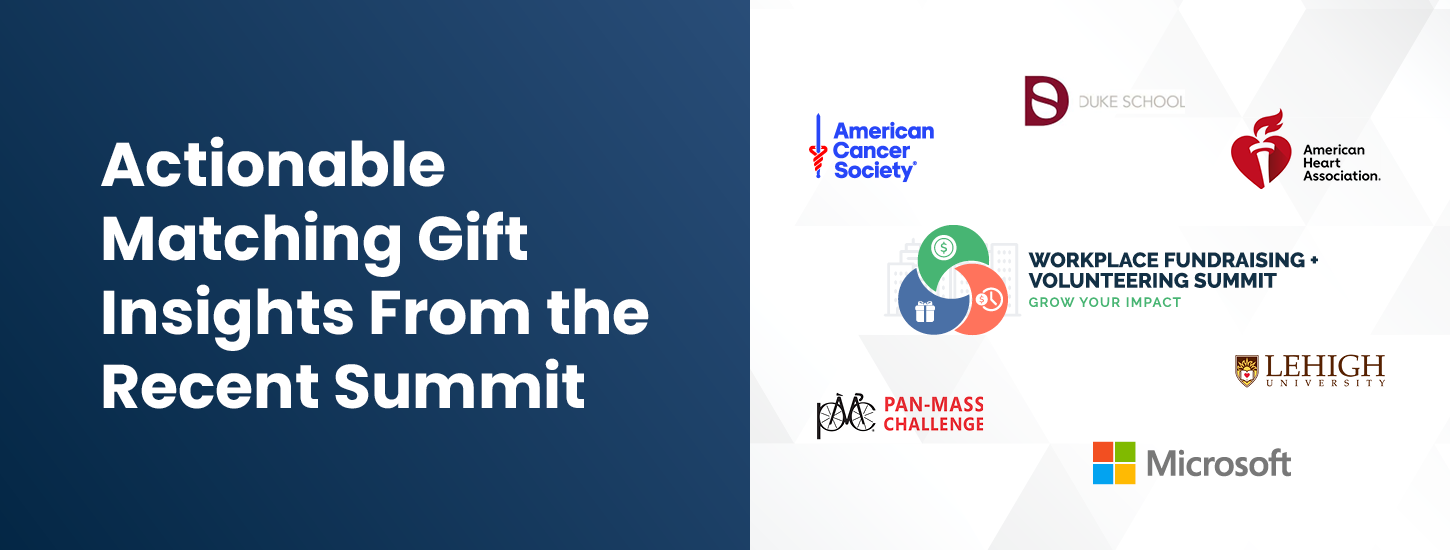6 Actionable Matching Gift Insights From the Recent Summit
Matching gifts are an untapped resource for many nonprofits. They provide an opportunity to maximize fundraising efforts by leveraging corporate dollars, and when done right, they can significantly boost revenue.
At the recent Workplace Fundraising + Volunteering Summit, several experts shared their best practices for driving matching gift revenue, offering actionable insights for nonprofits looking to raise more through matching gifts. Let’s dive into six key takeaways that can help nonprofits supercharge their matching gift strategies.
- Register with CSR platforms.
- Centralize your matching gift processing.
- Tell engaging, impact-driven stories.
- Leverage seasonal campaigns.
- Ensure effective matching gift tracking and attribution.
- Look to the future of matching gifts.
Meet the Speakers:
- Detra Foster of the American Heart Association
Detra Foster is the Senior National Matching Gift Operations Lead at the American Heart Association. With years of experience in fundraising and workplace giving, she is dedicated to expanding the impact of matching gifts and workplace giving.
- Stacy Devivo of Lehigh University
Stacy DeVivo serves as the Assistant Director of Information Processing at Lehigh University, where she leads efforts to enhance the university’s matching gift program. Stacy has developed innovative strategies that increase participation in matching gifts.
- Karen Bergin of Microsoft
Karen Bergin is the Senior Director of Global Employee Engagement at Microsoft. There, Karen has helped Microsoft raise billions of dollars for nonprofits worldwide. Her team focuses on empowering employees to support causes they care about, with matching gifts playing a critical role.
- Annemarie Dillon of the American Cancer Society
Annemarie Dillon is the Director of Workplace Giving and Matching Gifts at the American Cancer Society. With extensive experience in nonprofit fundraising and matching gifts, Annemarie has played a key role in streamlining and expanding ACS’s matching gift initiatives.
As nonprofits continue to explore new ways to amplify their fundraising efforts, matching gifts remain an underutilized opportunity that can yield significant returns. With the right strategies in place, organizations like yours can tap into the full potential of workplace giving programs, unlocking a steady stream of additional revenue. Let’s begin.
1) Register with CSR platforms.
One of the first steps nonprofits should take to increase their matching gift revenue is to register with leading CSR platforms. These dedicated software solutions, such as Benevity, YourCause, and CyberGrants, are commonly used by corporations to manage employee giving and match donations. By registering with these platforms ahead of time, nonprofits become eligible to receive matching gifts from the companies that use them.
Laurel Palmer, Director of the Kalamazoo College Fund, shared that partnering with these platforms is vital for raising matching gifts. She emphasized the importance of ensuring your nonprofit is listed and optimized on platforms like Benevity to access matching gifts from a wide range of corporate partners. By doing so, nonprofits open the door to significant contributions from employees of companies already engaged in matching gift programs.
If you’re not already listed on these platforms, Benevity is a great place to start. Many large companies, including keynote speaker Microsoft, use Benevity to manage their employee-giving programs, making it a critical tool for boosting workplace donations. Getting listed on these platforms not only provides access to these funds but also integrates your organization into a well-established and trusted giving process.
We recommend establishing an up-to-date account with each of the major CSR platforms, along with other CLMA-certified solutions. Here are a few popular names to help you get started:
- Largest CSR Platforms
- America’s Charities
- Benevity
- CyberGrants
- YourCause
- CLMA-Certified Platforms
- Givinga
- Millie
- Selflessly
- Uncommon Giving
To hear more from Microsoft’s keynote presentation, access the recording here.
2) Centralize your matching gift processing.
When it comes to matching gifts, centralizing your processing can make a world of difference in terms of efficiency and accuracy. During the summit, Annemarie Dillon of the American Cancer Society shared how centralizing their matching gift operations helped streamline their efforts, reduce errors, and ensure that all matching gifts were properly tracked and credited.
Before centralization, the American Cancer Society had local chapters handling matching gift confirmations, leading to process inconsistencies and missed opportunities going unclaimed. By consolidating the process at the national level, however, they were able to improve communication, set clear roles, and ensure accurate tracking across the organization.
For smaller nonprofits, starting small by centralizing matching gift communications can be a first step. As Sara Herring from the Crohn’s and Colitis Foundation explained, even something as simple as creating a dedicated matching gift email address or inbox can be a game-changer. This allows for better communication and organization, reducing the chances of missing out on matching gift opportunities.
3) Tell engaging, impact-driven stories.
Incorporating storytelling into your matching gift campaigns can significantly boost engagement and donor participation. Stacy DeVivo of Lehigh University shared how a compelling donor story about a couple who met at the university and are passionate about supporting their alma mater through matching gifts resonated with their audience.
By showcasing real-life examples of how matching gifts have made a difference, nonprofits can build stronger emotional connections with their supporters. This personal touch has measurable results. Lehigh University saw a 430% increase in email click-through rates and a 563% increase in web traffic after sharing the donor story. In other words, storytelling humanizes the matching gift process and motivates donors to engage with the program.
For nonprofits, communicating stories of real donors or corporate partners can inspire others to follow suit in matching gifts. Highlight the personal impact that matching gifts have on your mission, and share those stories across your communication channels, including email, social media, and on your website.
4) Leverage seasonal campaigns.
Another key insight from the summit was the importance of leveraging seasonal campaigns to drive matching gift participation. For example, Detra Foster from the American Heart Association shared how matching gift marketing aligns well with the timing of major fundraising events like Giving Tuesday and year-end giving campaigns.
At Lehigh University, Stacy DeVivo’s team capitalized on the Match Month opportunity (also known as February) by promoting matching gifts through social media, email, and custom graphics. Additionally, they utilized Matching Wednesday, a campaign initiative following giving day Giving Tuesday, to sustain momentum and encourage additional giving.
For nonprofits, aligning matching gift appeals with these high-traffic giving days creates urgency and encourages donors to take advantage of matching opportunities before the year ends. Whether it’s Giving Tuesday, Year-End Giving, or Match Month, seasonal campaigns provide an excellent platform for promoting matching gifts. By timing your campaigns around these major events, you can maximize the impact of matching gift opportunities and create a sense of urgency that motivates donors to act. Don’t forget to remind donors of the matching gift deadline around these key dates!
For more on marketing matching gifts and what your peers are doing, access the on-demand panel discussion here.
5) Ensure effective matching gift tracking and attribution.
Tracking and attributing matching gifts can be one of the biggest challenges for nonprofits. As Jessica Otto Guay from the Pan-Mass Challenge explained, many nonprofits face difficulties when donations come in bulk, without clear breakdowns of which donations are being matched. Annemarie Dillon echoed this point, sharing how her team has become adept at tracking down matching gift donations through detective work, including cross-referencing payments with donor records and checking remittance slips.
Effective data management is crucial in ensuring that matching gifts are attributed to the correct donors. Sara Herring from the Crohn’s and Colitis Foundation recommended using CRM systems to track and organize matching gifts. They use a unique identifier system to ensure each donation is correctly categorized and attributed, and they flag matching gift data early in the process to avoid confusion later.
By implementing clear tracking systems, using CRM tools, and developing processes for handling bulk donations, nonprofits can reduce errors and ensure donors are properly credited for their contributions. This not only helps with reporting but also strengthens donor relationships by accurately acknowledging their participation.
For more insights and best practices for matching gift processing, watch the presentation recording here.
6) Look to the future of matching gifts.
Looking ahead, Detra Foster from the American Heart Association shared her thoughts on the future of matching gifts, particularly in terms of technology and evolving donor behavior. As she pointed out, the future of workplace fundraising will likely involve integrating AI and generative tools to personalize outreach and improve marketing strategies. These tools could help nonprofits create more effective, targeted campaigns that resonate with donors.
Another key trend is the rise of corporate volunteer programs, in which employees’ volunteer hours are converted into financial contributions to nonprofits. Microsoft has been at the forefront of this trend, offering $25 per hour for every hour its employees volunteer. According to Microsoft’s Karen Bergin, this volunteer time donation model is an exciting avenue for nonprofits to explore, especially as more companies invest in volunteer programs.
As the landscape of workplace giving continues to evolve, nonprofits must stay adaptable and leverage new technologies to streamline processes, personalize outreach, and engage employees in new ways. Whether through AI, volunteer time conversion, or more personalized marketing strategies, nonprofits should continue to innovate and adapt to the changing dynamics of workplace giving.
Wrapping Up
Matching gifts are a powerful, yet often underutilized, tool for nonprofits looking to maximize their fundraising efforts. By following the actionable insights shared by experts during the summit (such as registering with CSR platforms, centralizing matching gift processes, telling engaging stories, leveraging seasonal campaigns, ensuring accurate tracking, and looking to the future), nonprofits can significantly boost their matching gift revenue and deepen their relationships with donors.
It’s important to remember that matching gifts are not a one-time effort, but an ongoing process. By staying organized, collaborating across teams, and continuously refining strategies, nonprofits can create a sustainable and effective workplace giving program that drives long-term success.






